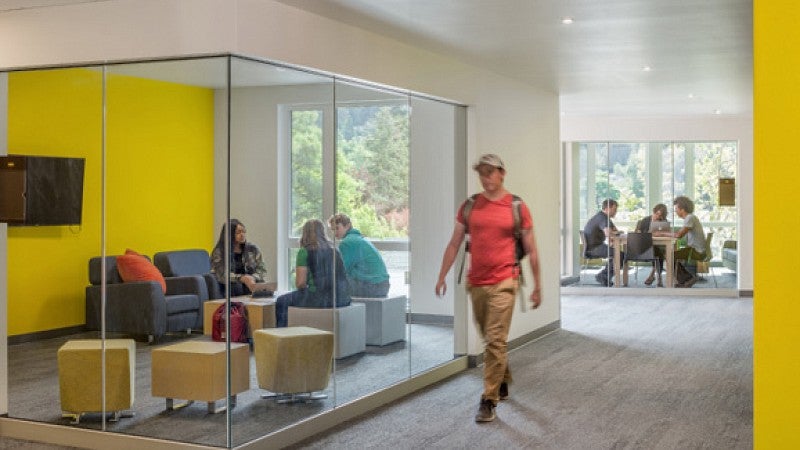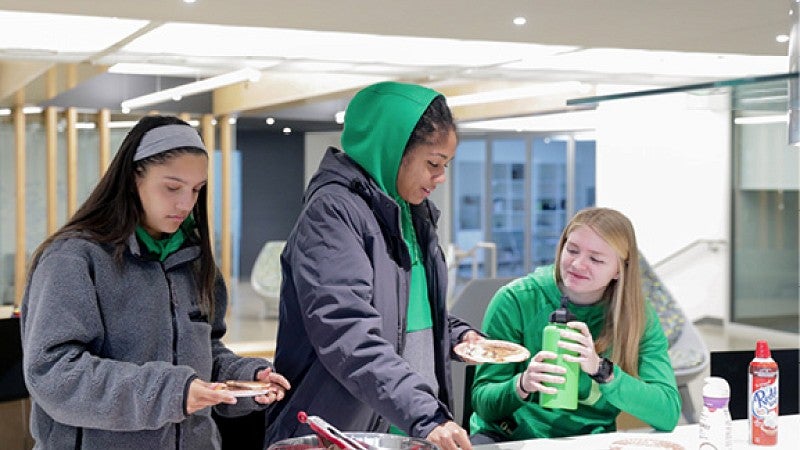If you hear a symphony of voices echoing off the walls and smell the sweet aroma of syrup and home-cooked pancakes, it must be Sunday at Kalapuya Ilihi residence hall, where Debra Thompson—known to students as Dr. T—hosts a weekly gathering. “Every Sunday, my partner and I make pancakes. Students come, and we listen to NPR and talk about politics,” says the associate professor of political science and faculty member-in-residence, who resides onsite with her partner and two-year-old daughter. “In one hour, students eat approximately 150 pancakes. It’s a thing, and it’s the best day of the week.”
But pancakes and politics are only part of the appeal of UO’s newest residence hall. Kalapuya Ilihi, which opened last fall to approximately 500 students, houses four new academic communities and honors one of Oregon’s indigenous peoples.
The building’s name recognizes that the Kalapuya, part of the Confederated Tribes of Grand Ronde and the Confederated Tribes of Siletz Indians, were the first residents of the Willamette Valley. In the Native American language of Chinuk Wawa, “Ilihi” means homeland. “We wanted to choose a name that reflected something powerful for Native people,” says Brian Klopotek, associate professor of ethnic studies and program director for the Native American studies minor. “This is a way of acknowledging the territorial host, the Kalapuya people, and recognizing that this is their homeland.”

The homage to Oregon’s indigenous peoples continues in and around the building with original artwork by James Lavadour, a member of the Walla Walla tribe whose paintings reflect his people’s connection to their northeast Oregon homeland, and a bronze casting of a sculpture by the late Rick Bartow, a Wiyot tribal member from Newport.
Just west of the new hall is the Many Nations Longhouse, a community space for Native American students. Designed by Native American architect and UO alumnus Johnpaul Jones, ('67, BArch, architecture), the center must have an unfettered view of sunrise for ceremonial purposes. To accommodate that, Portland-based Mahlum Architects conducted extensive solar studies to ensure that neither Kalapuya Ilihi Hall nor Global Scholars Hall casts a shadow on the longhouse at any time.
“That whole little area is like a Native American quad now, because we’ve got the longhouse, we’ve got Kalapuya Ilihi Hall. The Northwest Indian Language Institute is right there. We’ve got the Rick Bartow sculpture in the middle, so it all comes together in a really nice way,” Klopotek says.
The building’s architecture further promotes a sense of community, with multiple learning and collaborative spaces that enable students and faculty members to get together. Highlights include a bright and airy maker- and hacker-space for students to work on projects or satisfy artistic impulses, glass-enclosed study rooms, and plenty of lounge spaces.
The residence hall is also home to new academic residential communities (ARCs) that offer students with shared academic interests or majors an opportunity to live and study together with teachers, advisors, tutors, and peer mentors. The communities, all based on social justice, cover Native American and indigenous studies, art and design, social activism, and media and social action.
Maya Banyacski, class of 2021, was drawn to the ARC for social activism, which is run by the law school. Although her major is biology, she feels that participating in the ARC will serve her in whatever career she pursues. “In every field, you need to interact with other people,” Banyacski says, “and it’s important to respect them and make them feel like their voices are being heard.”
Through the ARC, passionate advocates for justice and social change such as Banyacski take courses on environmental law and policy, ethics, and conflict resolution; studies culminate with a final project on a social issue. Over just one term, Banyacski and her peers have formed tight bonds. “We get along really well,” she says. “We hang out together outside of class and check in with each other. It’s great community-building.”
Living on campus and participating in an ARC helps incoming students feel at home in the university, according to Kevin Hatfield, adjunct assistant professor of history and director of Academic Residential and Research Initiatives. “Students have an early opportunity to get to know and be known by a professor, which sometimes can be challenging at a large research university,” Hatfield says. “ARCs are really about relationships and community and fostering that sense of belonging.”

Having a faculty member in residence is also a big plus for first-year students. Thompson is more than happy to engage hallmates in conversations about her research areas, which include race and ethnic politics, inequality, and American political development—but that’s not the only reason Kalapuya Ilihi residents appreciate her.
Nicole Levi, class of 2021, just likes to have a professor close at hand. “If I need study help or I feel like I’m not really studying effectively, or if I have a question about what she teaches, then she’s right here, which is so nice,” Levi says.
Describing her residence position as “a happy side job,” Thompson sees her role as an informal advisor. She stresses the importance of living on campus for all first-year students, regardless of whether they join an ARC.
“A lot of what I do is like drive-by advising, so I’ll see students walking down the ramp and they’re like, ‘Hey where do I get a parking pass?’” Thompson says. Some students, she adds, “don’t have someone to say, ‘Oh, you didn’t show up at class today, what’s going on?’—so sometimes it’s just waving at them as they pass by. It’s important to have somebody who just acknowledges your existence.”
RESIDENCE HALLS AND YEAR BUILT, BY DECADE
2010s
- Global Scholars Hall,v2012
- Kalapuya Ilihi Hall,v2017
2000s
- Living-Learning Center, 2006
Pre-1980
- Carson Hall, 1949
- Earl Hall (AKA Earl Complex),v1955
- Walton Hall (AKA Walton Complex): south wing, 1957; north wing, 1959
- Hamilton Hall (AKA Hamilton Complex),v1961
- Bean Hall (AKA Bean Complex), 1963
- Riley Hall, 1964
- Barnhart Hall, 1966
KALAPUYA ILIHI HALL AMENITIES
- Community Kitchen
- All Utilities Paid
- Lounge, Study Spaces
- In-Building Laundry
- Wi-Fi
- 24/1 On-Call Staff
- Covered Bike Racks
- Maker- and Hacker-Space for Art and Other Projects
- Seminar Room


